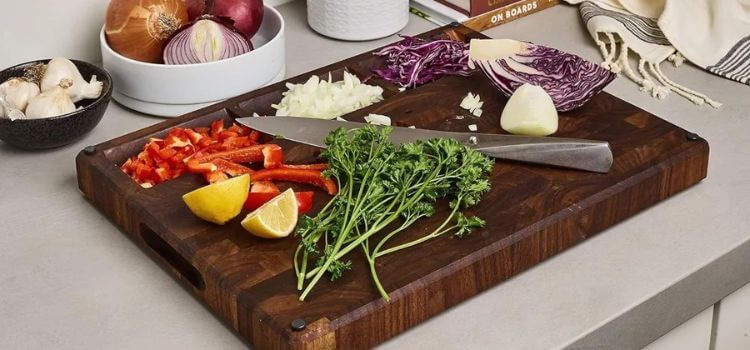As an Amazon Associate, I earn from qualifying purchases

Cutting boards are a staple in every kitchen, often underestimated yet crucial for food preparation. With a variety of options available, choosing the right type can be a perplexing task. Among the contenders, end grain cutting boards are frequently touted as superior. But are they truly better? Let’s delve into the world of cutting boards to find out.
When it comes to cutting boards, the market offers an array of materials and styles—plastic, bamboo, edge grain, and end grain, to name a few. Each type has its unique characteristics and advantages. However, end grain boards have gained special attention for their distinctive design and benefits.
End Grain Cutting Boards Defined
An end grain cutting board is constructed in such a way that the wood fibers are arranged vertically. Imagine the surface of the board as the tops of straws bundled together. This unique configuration gives end grain boards their characteristic checkerboard pattern and is key to their celebrated performance.
Benefits of End Grain Cutting Boards
- Durability and Longevity: One of the standout features of end grain boards is their durability. Thanks to their vertical grain structure, these boards are often described as “self-healing.” When a knife cuts into the surface, the wood fibers separate but then close back up, minimizing visible scars. This self-healing property not only extends the life of the board but also maintains its aesthetic appeal over time.
- Knife-Friendliness: For those who invest in quality kitchen knives, the knife-friendliness of an end grain board is a major plus. The same self-healing characteristic that aids in board longevity also reduces wear on knife blades. As the knife descends, it moves between the wood fibers rather than cutting across them, which can dull blades. Consequently, knives stay sharper for longer, cutting down on maintenance and replacement costs.
- Natural Antibacterial Properties: Wood inherently possesses antibacterial properties. Studies have shown that wood can naturally inhibit bacterial growth, making end grain boards a more hygienic choice than some other materials. The fibrous surface allows for quick drying, which minimizes the time bacteria have to multiply. This makes end grain boards not just practical, but also a safer option for food preparation.
Comparison with Other Cutting Board Types

Edge Grain Cutting Boards
Edge grain boards are often confused with their end grain counterparts. While both are made of wood, they differ in construction. Edge grain boards are made by gluing together the long edges of wood strips. They are generally more affordable and lighter than end grain boards, but they lack the self-healing properties and can show knife marks more readily.
Plastic Cutting Boards
Plastic boards are popular due to their affordability and ease of cleaning, often being dishwasher-safe. However, they tend to wear quickly, which can lead to deep grooves where bacteria can reside. They also lack the aesthetic beauty and knife-friendliness of wood. While suitable for certain tasks, they may not provide the longevity or safety of wood boards.
Bamboo and Other Materials
Bamboo boards are an eco-friendly choice, being made from a sustainable resource. They are harder than most wood boards, which can be a double-edged sword—they resist cuts but can be tough on knives. Other materials, like glass or marble, are best avoided for regular cutting tasks, as they can severely dull knives and pose a safety risk when they become slippery.
Factors to Consider When Choosing a Cutting Board
- Maintenance Requirements: End grain boards require regular maintenance to preserve their beauty and function. This includes oiling the board to prevent drying and cracking. Oiling is a simple process but must be done consistently to maintain the board’s condition.
- Cost Considerations: End grain boards are an investment. They tend to be more expensive due to the complexity of their construction and the quality of wood used. However, their durability and knife-friendliness can justify the price for avid cooks who value performance and longevity.
- Aesthetic Appeal: If aesthetics play a role in your decision, end grain boards are undeniably attractive. Their distinct checkerboard pattern can add a touch of elegance to any kitchen. They’re often used as serving platters, doubling up as a functional yet decorative piece.
Conclusion
When evaluating whether end grain cutting boards are the better choice, it truly depends on individual needs and preferences. They offer unmatched durability, knife-friendliness, and a natural antibacterial advantage. However, they require regular maintenance and come at a higher initial cost. For those who value these benefits and are willing to invest in a quality kitchen tool, end grain boards are an excellent choice.
They blend functionality with aesthetics, making them a worthwhile addition to any kitchen. Whether you’re a professional chef or a home cook, understanding the merits of end grain boards can help you make an informed decision, ensuring your cutting surface supports your culinary adventures for years to come.
FAQ
What is the disadvantage of end grain cutting board?
End grain cutting boards can be more expensive and require regular maintenance, such as frequent oiling, to prevent drying and cracking. They are also heavier and more cumbersome to move around the kitchen, making them less convenient for quick or frequent use compared to lighter board options.
What is the benefit of an end grain cutting board?
End grain cutting boards offer superior durability and self-healing properties, which prolong their lifespan. They are gentle on knives, reducing blade wear and tear. Additionally, their natural antibacterial properties enhance food safety, and their distinctive checkerboard pattern adds aesthetic value to any kitchen.
Do end grain cutting boards dull knives?
End grain cutting boards are less likely to dull knives compared to other types. Their vertical wood fibers allow the blade to slide between, rather than cut across, minimizing resistance and preserving sharpness. This makes them a preferred choice for maintaining knife edges over time.
As an Amazon Associate, I earn from qualifying purchases